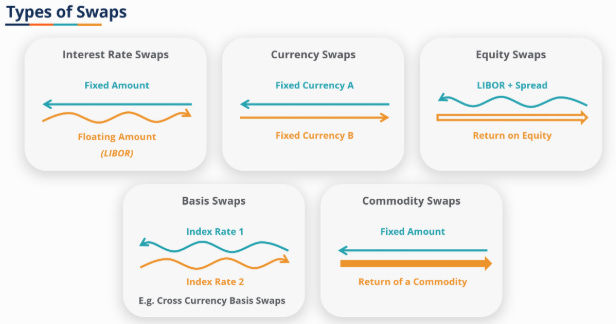Why Swap Spreads and Basis Matter for Short-Term Interest Rates
When I first heard terms like swap spreads and basis, I’ll admit I felt a bit intimidated. These concepts sounded like something only Wall Street pros would discuss. But as I dug deeper, I realized they are not only easy to grasp, they’re also extremely useful for understanding what’s happening in the markets – especially for short-term U.S. interest rates. In this post, I want to walk you through what swap spreads and basis mean in plain English, how they’re used, and why they matter for traders like us. I’ll share recent examples (from 2024 and 2025) to show how these spreads have shifted and what those moves might be signaling about things like Federal Reserve policy, funding pressures, or even perceptions of risk. My goal is to keep it personable and straightforward, avoiding excessive jargon. By the end, you should have a clear sense of why swap spreads and basis are worth keeping an eye on in today’s macro environment.
What Are Swap Spreads?
Let’s start with swap spreads. Interest rate swaps are a type of derivative where two parties exchange cash flows – typically one pays a fixed interest rate and the other pays a floating rate (often linked to an overnight rate like SOFR, the Secured Overnight Financing Rate). The swap rate is effectively the fixed interest rate that makes this exchange fair given market expectations. Now, a swap spread is simply the difference (in basis points) between that swap’s fixed rate and the yield on a U.S. Treasury of the same maturity. For example, if a 2-year interest rate swap has a fixed rate of 4% and the 2-year Treasury note yields 3.8%, the 2-year swap spread would be 0.20%, or 20 basis points.
Why would there be a difference at all between a swap rate and a Treasury yield? After all, both reflect interest rates over the same period. The reason is that swaps and Treasuries have different risk and demand characteristics. A U.S. Treasury is a government bond – traditionally viewed as “risk-free” in terms of credit (since the U.S. government is expected to pay its debts) – and its yield is driven by investor demand for safe assets and by the supply of government debt. A swap, on the other hand, is a contract between private parties (usually mediated by a clearinghouse these days). The swap’s fixed rate is influenced by expectations of the Fed’s policy rates (since the floating leg tracks an overnight rate) and by funding conditions (because to hold a Treasury, investors often borrow cash, whereas a swap might not tie up as much capital).
In general, traders consider swap spreads as one gauge of strain or premium in bond markets. A positive swap spread means the swap’s fixed rate is higher than the Treasury yield – historically that was common, reflecting a slight premium for swaps (partly due to credit risk in the old Libor-based swaps and the convenience of Treasuries). A negative swap spread means the swap rate is actually lower than the Treasury yield, which can happen due to unusual supply/demand dynamics or risk perceptions. Importantly, swap spreads are expressed in basis points (bps) and can change with market conditions. For instance, if Treasuries are in high demand as safe havens (pushing their yields down sharply) while swap rates don’t fall as fast, swap spreads might widen (become more positive). Conversely, if there’s heavy issuance of Treasuries or other factors pushing Treasury yields up relative to swap rates, the spread can narrow or even go negative.
Recent Example: In late 2023, something unprecedented happened at the short end – U.S. 2-year swap spreads turned deeply negative, reaching about -23 bps (meaning the 2-year swap rate was 0.23% below the 2-year Treasury yield). This was the most negative (tightest) level on record for that spread. It largely reflected two things: first, a transition in the swap market away from Libor to SOFR, which removed the old credit risk premium that used to keep swap rates higher; and second, a sense that U.S. Treasuries weren’t quite as risk-free as before, at least in terms of supply and fiscal outlook. In other words, investors started to demand slightly higher yields on short-term Treasuries (due to concerns like large government deficits or even credit rating worries), while the new SOFR-linked swaps were trading closer to a “pure” risk-free rate. The result was a negative swap spread.
Fast-forward to early 2024, and those 2-year swap spreads had moved back less negative (around -14 bps) as speculation grew that the Fed might slow or pause its balance sheet runoff (quantitative tightening). The reasoning was that if the Fed stops shrinking its bond holdings, the Treasury would issue fewer new bonds, easing the supply pressure that had been holding down Treasury prices. Indeed, analysts noted that the whole swap spread curve had widened a bit in January 2024 on hopes of a QT taper – and the short-end spreads widened (became less negative) the most. By that time, the 2-year spread was no longer at record tights, indicating a slight normalization. However, as of the first half of 2025, short-term swap spreads were still quite suppressed – hovering around -20 bps in the 2-year tenor. The persistence of negative swap spreads tells us that some of those structural pressures (like heavy Treasury supply and the lack of any credit premium in swaps) are still in play.
What Is “Basis” in Interest Rates?
Keep reading with a 7-day free trial
Subscribe to Global Macro Method to keep reading this post and get 7 days of free access to the full post archives.


